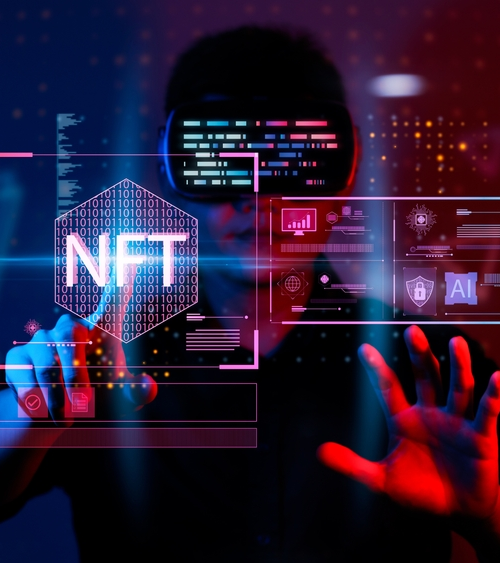Troy Warren for CNT #NFT
The term “metaverse” was coined by Neal Stephenson in his 1992 novel, Snow Crash.
In this book, the metaverse was a virtual, interactive universe accessible through special goggles, where individuals could build, explore, interact, conduct business, and do much, much more. Nearly three decades later, the tech community is working towards making this idea a reality.
Decades of Dreaming
The idea of a virtual universe adjacent to the physical has captured the imagination of scientists and storytellers for decades. The concept was first presented as something called cyberspace in William Gibson’s 1984 science fiction novel Neuromancer. This early vision of a virtual universe was one constructed from visual representations of abstracted data, conjuring a rather Tron-like vibe.
“A consensual hallucination experienced daily by billions of legitimate operators, in every nation, by children being taught mathematical concepts… A graphic representation of data abstracted from the banks of every computer in the human system. Unthinkable complexity. Lines of light ranged in the nonspace of the mind, clusters and constellations of data. Like city lights, receding.”
Since then, the concept has resurfaced in countless science fiction books and movies. More complete virtual universes have been presented in books such as Ready Player One, Otherland, and Altered Carbon. But perhaps the most widely known representation of the concept is also its most technologically advanced and depressingly dystopian version, as seen in the setting of the Wachowskis’ 1999 film, The Matrix.
From all these iterations came a new, further-reaching conception of a metaverse, The (capital “M”) Metaverse – a singular, encompassing virtual universe of different, yet interconnected and interoperable virtual spaces, that provides seamless augmentation to the physical world.
The Road To The Metaverse
In reality, many virtual worlds already exist online. Some examples include Roblox and Decentraland, where denizens can purchase land and build their own environments, applications, and marketplaces. These virtual worlds offer a variety of activities, games, and virtual spaces where denizens can interact, and they’ve proved to be viable alternative spaces for real-world activities, especially during the COVID-19 pandemic.
Decentraland and Roblox are often called metaverses. By definition, they are – a metaverse is simply “a virtual-reality space in which users can interact with a computer-generated environment and other users”. When people talk about NFTs with metaverse tie-ins, this is the context to which they refer – almost all items in metaverse platforms like Roblox and Decentraland are NFTs, because they allow verifiable ownership of digital assets and enable interoperability.
However, virtual world platforms like these are far from what we envision in The Metaverse. – not one virtual world, but all of them interconnected.
At its heart, The Metaverse is more akin to the internet itself than a virtual world platform. It is meant to be an interactive virtual environment as encompassing and useful in its offerings as the internet is, that enables a more natural mode of engagement, and that connects seamlessly to the real world in terms of access, utility and value generation. It’s meant to be a virtual universe that will augment our own, and unfetter us from the limitations of our physical world.
What this requires, is the development of an ecosystem of tools, services, and applications that integrate seamlessly with one another and with a variety of hardware. This means a level of collaboration between industry players that far surpasses what we see in the world today.
NFTs Help Make This Dream A Reality
While many have toyed with the idea, none have ever attempted to create The Metaverse. This is because enabling interoperability on the scale required for such a system presents significant technological and policy challenges.
In recent years however, the idea has gained more traction than ever because blockchain technologies have shown promise in helping developers overcome some of these hurdles.
Specifically, NFTs have enabled the verifiable ownership and interoperability of digital assets. These are crucial features in The Metaverse, where digital assets need to be tied to one individual, while still being transferable between different applications and services.
In a true Metaverse, denizens would be able to seamlessly move between different virtual spaces while retaining the same avatars, identities and assets. NFT standardization provides the structure that makes this interoperability possible.
In combination with the potential of cryptocurrencies in providing an improved virtual payment rail, NFTs have opened the door for the facilitation of a singular, metaverse-wide virtual economy that doesn’t suffer from the same problems of fragmentation we see across virtual economies now, which are mostly still enclosed and separate.
As promising as this is, there’s a lot more to be done before The Metaverse can be realized. One remaining challenge is in the creation of industry standards across a variety of other activities, such as with hardware integration. The bigger challenge is that of adoption – many companies would likely be reluctant to participate in open economies and platforms because of the financial and strategic risk posed.
Giving It A Red-Hot Go
Facebook’s CEO, Mark Zuckerberg, has been obsessed with The Metaverse for years. At the end of June this year, he announced that Facebook would become a “metaverse company”, and is investing $50 millioninto research and initiatives that would help develop The Metaverse “more responsibly”. What this means coming from him, is anyone’s guess.
While actualization is still a long time away, and many more in the industry will have to get involved for it to happen, this move by the biggest social media company today is the first real step being taken towards The Metaverse. Who knows, we may even see it in our lifetime.




































